 Psychedelics may not be the first thing you think of upon hearing the name Stanislav Grof. However, Grof’s association with Sasha Shulgin should come as no surprise considering that this renowned psychiatrist has spent more than 50 years researching the healing and transformative potential of non-ordinary states of consciousness. Grof is best known as a founding father of transpersonal psychology, which is defined as “the study of humanity’s highest potential, and with the recognition, understanding, and realization of unitive, spiritual, and transcendent states of consciousness” (Lajoie, D. H. and Shapiro, S. I. “Definitions of Transpersonal Psychology: The First Twenty-three Years.” Journal of Transpersonal Psychology, Vol. 24, 1992). In fact, Grof helped create the Journal of Transpersonal Psychology and is the founding president of the International Transpersonal Association.
Psychedelics may not be the first thing you think of upon hearing the name Stanislav Grof. However, Grof’s association with Sasha Shulgin should come as no surprise considering that this renowned psychiatrist has spent more than 50 years researching the healing and transformative potential of non-ordinary states of consciousness. Grof is best known as a founding father of transpersonal psychology, which is defined as “the study of humanity’s highest potential, and with the recognition, understanding, and realization of unitive, spiritual, and transcendent states of consciousness” (Lajoie, D. H. and Shapiro, S. I. “Definitions of Transpersonal Psychology: The First Twenty-three Years.” Journal of Transpersonal Psychology, Vol. 24, 1992). In fact, Grof helped create the Journal of Transpersonal Psychology and is the founding president of the International Transpersonal Association.
Grof also created and continues to lecture and teach professional training programs in holotropic breathwork, which “combines accelerated breathing with evocative music” to help individuals “enter a non-ordinary state of consciousness.”
This is not the time or place to write an extended treatise on transpersonal psychology or holotropic breathwork. Needless to say, however, Grof and many others consider psychedelics to be an important gateway to altered states of consciousness in which individuals can experience and connect with the divine. Ann Shulgin touched on this in her Transform Press newsfeed post about her “spiral” experience, which she first detailed in PiHKAL.
In the following excerpt from the PiHKAL/TiHKAL Memorial Edition, Grof writes about new developments in research into the therapeutic potential of psychedelic drugs in treating many conditions that have proven difficult, if not impossible, for conventional medicine.
Sasha and Ann’s seminal volumes PiHKAL and TiHKAL, treasure troves of knowledge about psychoactive substances, will remain classics of great importance providing information and inspiration for future generations of researchers. In the current extraordinary renaissance of interest in psychedelic research, it is already happening. Studies showing great therapeutic potential of MDMA in PTSD, a disorder that presents formidable psychiatric, economic, and political problems and for which no other effective treatment is known, might make this substance the first entheogen/psychedelic substance to become mainstream medicine.
New research conducted at several major American universities seems to be confirming the clinical value of psilocybin– and LSD-assisted psychotherapy in the work with cancer patients and in several other indications which were reported in professional literature in the 1950s, 1960s, and early 1970s. Ketamine, a dissociative anesthetic with psychedelic properties, is now being widely used in the treatment of depression. Ralph Metzner’s excellent book The Toad and the Jaguar is a goldmine of information collected from individuals and groups who had conducted semi-legal and underground therapy and research. The data contained in it point to therapeutic value of tryptamine entheogens, particularly methoxy-DMT, waiting to be confirmed by controlled clinical studies.
![]()
